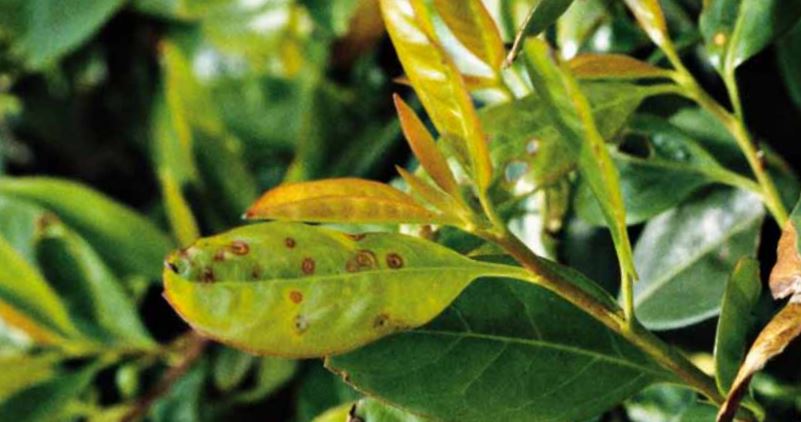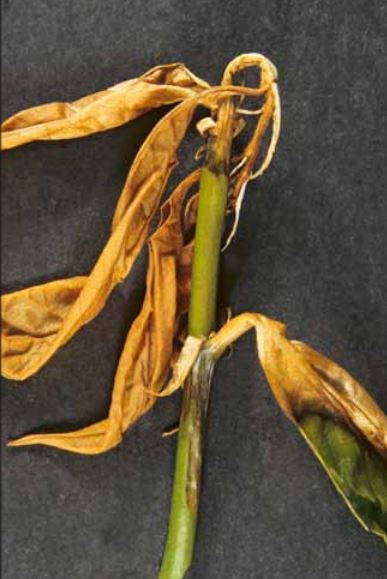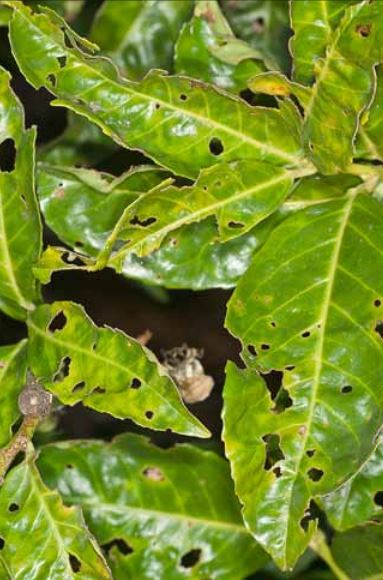Please click here to access the main AHDB website and other sectors.
- Home
- Knowledge library
- Bacterial shot-hole of cherry laurels: symptoms, pathogen and biology
Bacterial shot-hole of cherry laurels: symptoms, pathogen and biology
Find information on the symptoms, pathogen, biology of bacterial shot-hole of cherry laurel.
This information was last updated in 2023.
Return to the main page: Bacterial shot-hole of cherry laurel
Symptoms
Disease symptoms can be quite variable. Typically, the disease is seen as brown necrotic leaf spots around 2 to 10 mm in diameter. In the very early stages, spots may have a water-soaked margin, most easily seen by holding an infected leaf up to the light. On younger leaves, spots develop a reddish border and a yellow chlorotic halo (Figure 1).
 S J Roberts
S J Roberts
Figure 1. Bacterial leaf spot symptoms on a young leaf of Prunus laurocerasus ‘Rotundifolia'.
Abscission layers develop around the spots which then eventually drop out to give the characteristic ragged, shot-hole appearance (Figure 2). Stems can also be infected to give cankers and shoot die-back especially in combination with frost (Figure 3).
 S J Roberts
S J Roberts
Figure 2. Leaf spots eventually drop out to give leaves a ragged appearance.
 S J Roberts
S J Roberts
Figure 3. Shoot dieback caused by a combination of frost and Pseudomonas syringae pv. syringae.
The shot-hole symptoms can be easily mistaken for insect damage. On the other hand, not all shot-hole symptoms are necessarily caused by bacteria and they are also reported to be caused by a number of different fungi. Probably the most common alternative cause of shot-holes in cherry laurels (especially in hedges) is infection by powdery mildews (Podosphaera spp.) (Figure 4).
 S J Roberts
S J Roberts
Figure 4. Shot-hole symptoms on P. laurocerasus ‘Rotundifolia’ caused by powdery mildew
 S J Roberts
S J Roberts
Figure 5. Marginal leaf necrosis can be a physiological problem.
Another cause of confusion is marginal leaf necrosis symptoms. This is a physiological problem associated with poor growing conditions (for example drought stress, water-logging or high growing media conductivity levels). Typically these brown areas at the edges of leaves drop off, giving the leaf margins a notched appearance (Figure 5).
Pathogen
In the UK, bacterial leaf spot and shot-hole of cherry laurel and related plant species is caused by the bacterium Pseudomonas syringae pv. syringae (Pss).
Another bacterium Xanthomonas arboricola pv. pruni (previously called X. campestris pv. pruni or X. pruni) also infects cherry laurel (and other Prunus species), and is often considered as the primary cause of shot-hole in N. America. This is a quarantine pathogen in the UK. Read more in this Defra factsheet.
There have been localised reports of X. arboricola pv. pruni on stone fruit subjects in France and Switzerland, and it has been reported on cherry laurel on nurseries in the Netherlands and Italy, and is regularly intercepted on imports into the UK from the EU and especially the Netherlands (15 in 2022). It has also been detected on UK nurseries since 2014 (9/1328 in 2015), but it is likely that most of these are imported material.
Host range
P. syringae pv. syringae is considered to have a broad host range that includes lilac, all Prunus species, Phaseolus beans and many other plant species. However, the precise host range is unclear and the scientific literature is confusing.
In limited host-range studies we found that pathogenic isolates from cherry laurel were able to infect lilac and forsythia and isolates from lilac and Prunus avium were able to infect cherry laurel. P. syringae pv. morsprunorum, which causes bacterial canker and shot-hole on sweet cherry and plums, did not infect cherry laurel (but has been reported to do so in Spain).
Ice nucleation activity
Pure water can be super-cooled to several degrees below 0°C without freezing. Adding an ice nucleus results in the rapid formation of ice crystal. Many strains of P. syringae including Pss that are pathogenic on cherry laurels are ice nucleation active and can therefore promote frost damage.
Infection and disease development
Pss can live on plant surfaces without causing symptoms. It enters plant tissues through natural openings, such as stomata and lenticels and through wounds. Thus, any events causing damage to plants, such as hail, frost, pruning, or other mechanical damage, may provide opportunities for infection.
Once inside the plant, bacteria multiply and symptoms develop as a plant response to invasion. Infections tend to be localised with little evidence of systemic spread within the the vascular system. Precise conditions for infection and disease development have not been established, but in artificial inoculation experiments, symptoms first became apparent about six days after infection at temperatures in the range of 15-22°C.
Epidemiology - sources and spread
Sources
Pathogenic isolates of Pss have been detected on apparently healthy leaves at all stages of production (mother-plants, cuttings, liners, production).
Stock plants, bought-in plants, previous years’ production and alternate host species may all serve as sources of inoculum. In 2020 (see CP 191) follow-up of production material grown from tested liners, suggested that the liners themselves were the primary source of infection.
Detection of the pathogen on apparently healthy leaves means that the absence of symptoms does not guarantee that the material is free from the pathogen.
P. syringae is generally considered to survive poorly in soil and growing media and so these are unlikely to be significant sources of inoculum. Crop debris and residues from previously infected batches may provide an inoculum source over the short-term, especially from crop to crop within a growing season, and particularly if the rate of debris breakdown is limited by dry or cold conditions.
Spread
Long distance dissemination is via contaminated or infected plant material.
Local (within-crop) spread occurs by water-splash, irrigation, or wind-driven rain, but anything that moves within and between crops (people, animals, insects, equipment, machinery) can potentially spread the bacterium, especially in wet conditions. It is important to be aware that considerable numbers of bacteria may be present and significant spread may have already occurred before any symptoms are seen.
Useful links
Final report of research project HNS 71: Hardy Nursery Stock bacterial diseases
Final report for research project HNS 91: Bacterial diseases of HNS: Chemical control
Research project HNS 179: Management of Bacterial Canker in Prunus spp
Research project CP 174: Review of bacterial pathogens of economic importance to UK crops
Research project CP 191: looking at Improved Management of Bacterial Diseases in Horticultural Crops
Download the original 2010 PDF version of this information
Author
Dr Steven J. Roberts, Plant Health Solutions Ltd., Warwick, UK.

